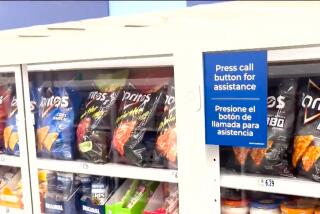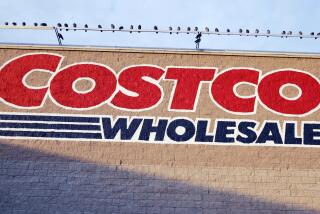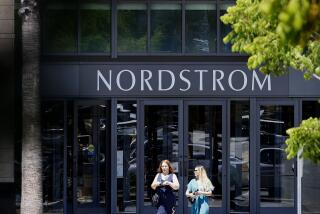Retailers Taking Aim at Employee Pilferage
Tim O’Connor knows he’s sent some of his co-workers to jail.
As vice president in charge of loss prevention for Fort Lauderdale, Fla.-based Mars Music, O’Connor is chief architect of the company’s aggressive approach to combating employee theft.
It’s a line of defense that includes prosecuting 70% to 80% of the employees caught stealing from the chain, which sells new and vintage musical instruments and high-end recording equipment. It features cameras trained on every register and a hotline that allows employees to blow the whistle on pilfering colleagues. “To outfit a new store [with security devices], we spend about $40 grand,” O’Connor said.
“There’s been a general shift in retailing,” said O’Connor, who has been with 5-year-old company for four years. “We’ve gotten other things cleaned up. Internal theft is where we’re losing our dollars. It’s a very small group of employees stealing a large amount of money.”
After years of trying to stem retail losses by watching out for shoppers with sticky fingers, retailers are increasingly aiming their anti-theft weapons at their employees, studies show, and criminologists and retailers confirm.
Some experts say that the retailing industry’s techno-assault on shoplifting--launched about 20 years ago with the advent of bulky sensor tags--has slowed the rate of growth in shoplifting losses, and in some retail segments has resulted in a drop in shoplifting.
Meanwhile, experts say, employees have been busy at the cash register and in the back room.
From plundered PlayStations to diverted dollars, employee theft is estimated to have cost retailers a record $15 billion in 2000, according to the National Retail Security Survey, which tracks trends in retail “shrinkage,” the industry term for theft, fraud and other unexplained losses.
“The focus on dishonest employees now may be higher than it’s ever been,” said Mark R. Doyle, vice president of Florida-based Jack L. Hayes International Inc., a consulting firm that helps businesses, especially retailers, reduce fraud losses.
Employee fraud cuts across business segments, from retailing to insurance to medicine, experts said. Retailers have been among the most active in trying to document and attack the problem. At least three studies released last year show that employee theft posses a bigger threat to them than “boosters,” as shoplifters are known in the vernacular.
The National Retail Security Survey, with data from 2000, showed that among 116 of the largest U.S.-based retail chains, employee theft accounted for 46% of losses, compared with 31% for shoplifting. By comparison, data from 1991 (the oldest comparable survey available) pegged shoplifting as the leading cause of loss--at 38.4% it barely edged out employee theft, which was 37.8%.
Loss prevention experts are split on the causes of the apparent shift toward internal pilfering. Some cited inroads retailers have made in addressing shoplifting, which reduced the portion of the loss “pie” attributable to outsiders. Some blamed the economy for stepping up the financial pressure on cash-strapped cashiers. In the boom economy of the ‘90s, others said, some employers skipped background checks in an effort to hire new recruits. In the process, less-than-desirable workers slipped in.
“The opportunity to make sure you were getting honest employees at every turn became harder,” said Britt Wood, a vice president with the International Mass Retail Assn. in Arlington, Va. “You needed to get somebody in there, so you had to make compromises.”
Wood said that for some of the nation’s largest retailers, the yearly growth in shoplifting losses is beginning to slow.
“Now there’s more of a plateau,” he said.
Some loss prevention professionals contend that the proportion of internal thievery has remained relatively constant over the years. The difference, they say, is the new focus by retailers, which has lead to more employee thieves getting caught.
A study released by Hayes International last year showed that 30 U.S.-based retail chains--with 2000 sales of $355 billion--caught 73,326 dishonest employees in 2000, a 10% increase over the 1999 figure. Those employers recovered an estimated $56.12 million in cash and stolen goods for an average cash value of $765.41. That’s more than six times the shoplifting average of $114.07.
In six of the last seven years, the number of employees caught stealing and the amount of loot recovered has increased by double digits compared with the previous year, Doyle said.
A report released last month by the National Supermarket Research Group, which tracked thefts at supermarkets and convenience stores since 1990, showed the ratio of internal and external fairly constant over the last decade--averaging about 54% for employee theft to 24% for shoplifting.
Donald Horan, director of loss prevention with Gordon Bros. Group, which handles liquidation sales for ailing retailers, said that may be because the grocery industry has not used technology to reduce shoplifting to the same extent as vendors of clothing and hard goods.
The grocery study said total losses, as percentage of sales, have remained at plus or minus 2%--small but still the equivalent of billions in lost profits.
“The previous focus on shoplifting did not reduce total shrink,” said Larry Miller, director of the Scottsdale, Ariz.-based supermarket research group. “So the retailer says, ‘If I’m focusing so much on shoplifting, and it’s not reducing my shrink I’d better focus on something else: employee theft.’”
Miller and Horan said retailers today are using technology to more closely track employee activity--everything from software that spots a cashier with an unusually high number of refunds to smart tags that can be placed on something as small as a bottle of aspirin.
“The same technology that beat down shoplifting in the mid-’90s is being retooled to address employee theft in the new century,” Horan said. In the works, experts said, are “auto ID” computer chips sophisticated enough to tell you that a carton of cigarettes left through the back door at 10 p.m. on Thursday. Although some shopkeepers swear by the increased use of surveillance equipment, some privacy experts wonder what the move will do to employee morale.
“Would you like to work in an environment where every time you blow your nose ... it’s on videotape,” said Lewis Maltby, president of the National Workrights Institute in Princeton, N.J., a spinoff of the ACLU.
“Putting a camera on every register is a real hardship on the employees and it shouldn’t be done unless it’s absolutely necessary.”
Mars Music’s O’Connor said that, because of privacy concerns, cameras were not installed in places such as break rooms. But he said use of cameras was promoted to employees as a safety feature. “It’s a big key to controlling shrink.”
Some retailers have opted to address the problem by focusing on who they put behind the cash register. Mal Ransom, vice president of Marina del Rey-based US Search Inc., said he’s seen more interest from retailers who want to use background screening to combat the twin problems of employee theft and high turnover.
“Retailers need to increase the bottom line,” he said. “And the fact is that employee turnover and theft costs them money.”
More to Read
Inside the business of entertainment
The Wide Shot brings you news, analysis and insights on everything from streaming wars to production — and what it all means for the future.
You may occasionally receive promotional content from the Los Angeles Times.










